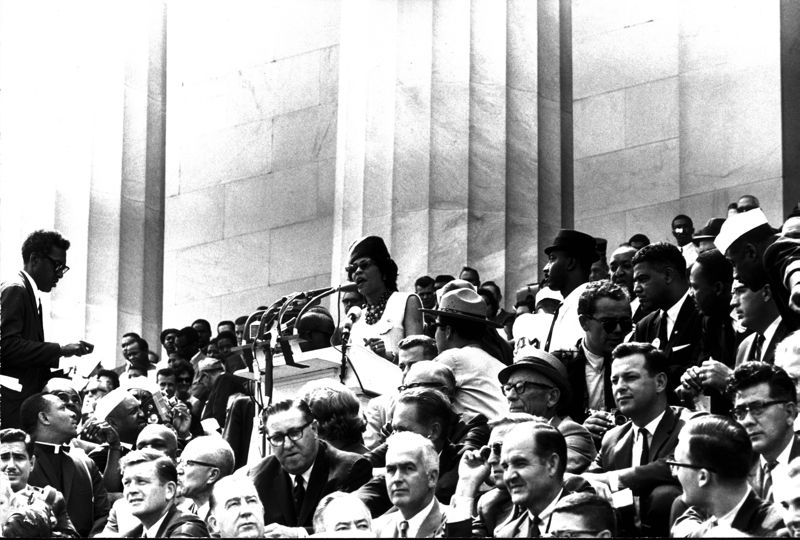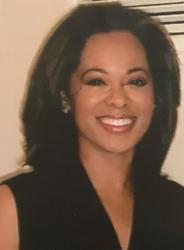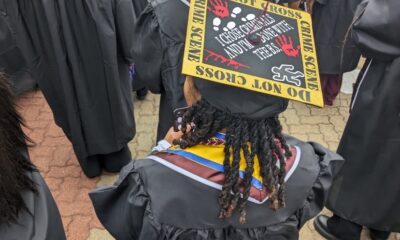News
Where Were the Women That August Day in 1963?

When the March on Washington is remembered Tuesday on its 55th anniversary, most will recall the soaring voice of Dr. Martin Luther King delivering his “I Have A Dream” speech. Some will remember Congressman John Lewis’ remarks, who as the fresh-faced leader of the Student Nonviolent Coordinating Committee, had been told to douse much of the fire in his speech and deliver a more watered-down version. But, where were the women?
“Josephine Baker sent a letter. I know she was supposed to speak. But my research says she sent a letter…she was not able to make it,” says Janis Kearney, author and Presidential diarist for former President Bill Clinton. “Mrs. Daisy Bates and Mrs. Rosa Parks were there, and Mrs. Parks made a very brief statement, a sentence or so. Daisy was the central female figure at the event.”
Kearney became close to Daisy Bates during the years they worked together at the Arkansas State Press Newspaper, which was owned by Bates and her husband. Bates had been the president of the Arkansas NAACP and the mentor for the Little Rock Nine, the African American students who integrated Central High School in 1957. When she retired from the newspaper, Kearney purchased it.
“Of course, Mahalia sang, and there were other women there,” Kearney says. “But, I searched, and I just did not see anyone else speak…other than those two women.”
Dr. Cherisse Jones-Branch, a history professor at Arkansas State University, questions the maternal niche history seems to push women into who worked in the Civil Rights Movement.
“What does that mean that women were encapsulated as the mothers of the movement?” she says. “Language matters. Does that exalt them or reduce them? It significantly undermines them and all the work they had been doing. Daisy Bates’ house had been blown up. They weren’t just sitting around making sandwiches. People had tried to kill them.”
The Jeanes Supervisors
In many ways, African American women were on the front lines of the struggle long before their work was identified. Jones- Branch cites the Jeanes Teachers or Supervisors, who were paid with monies from an endowment established in 1907 by Philadelphia philanthropist Anna T. Jeanes. Jeanes teachers worked in 16 southern states, providing education assistance for African Americans in rural communities between 1908 and 1968.
“They were leaders in the Black community in most cases,” Jones-Branch explains. “They were very well respected, and in many cases, they were brokers between black and white people. The way they moved between the communities they could procure things for black people. For example, they could say to the landowners, ‘Perhaps, if you provide better housing, they won’t be sick and will be better workers.’”
Jones-Branch explores how the Jeanes Supervisors helped quietly change the possibilities for some African Americans in the South in her upcoming book, Better Living by Their Own Bootstraps: Rural Black Women’s Activism in Arkansas.
“Often times the whites wanted black people to be subservient and subordinate and work in agriculture, but that’s not what is always happening in these schools,” Jones-Branch states. “One of the women I write about tells someone, ‘What you have to figure out is how to pay your poll tax so you can vote.”
The Jeanes Fund was still operating in 1963 when the crowd of 250,000 gathered on the National Mall for the March on Washington. Organizers had succeeded in getting thousands from all around the country to the nation’s capital for a protest in the middle of the week without the unrest the Kennedy Administration feared would endanger the Civil Rights Act President Kennedy had introduced. It was a hot day in late summer, but traditional roles held sway.
Jones-Branch adds, “It was hot out there, but they were dressed like they were going to church. How much of that is happenstance and how much of that is deliberate. You have to consider the ways in which the movement was very sexist.”
Kearney agrees, “I try to say it as softly as possible. It was the times, and it was the church. And, we know the church was patriarchal. Rev. King was a minister, and his closest allies were ministers or people who had close alliances with the church. The truth is the truth. The women did a lot of the hard and important work, but they were not given the recognition that the men were.”
Silent No More
Times have changed. Women started Black Lives Matter. And, one of the most visible protests of the last few years was staged by a woman: Bree Newsom who scaled a 30-foot pole and removed a Confederate flag from the South Carolina Statehouse.
“I think young women are doing a much better job of pushing for equality these days,” Kearney says. “They are less accepting of anything less than equality, more so than my generation was.”
On Tuesday when the nation observes the anniversary of the March, there will be a few who know the name of the woman who stepped to the podium and spoke to the crowd.
“Daisy Bates should have been a household name,” Kearney says. “If it had been another time…if the culture were different, she would have been.”

-

 Featured10 months ago
Featured10 months agoCalifornia Is the First State to Create A Public Alert for Missing Black Youth
-

 Featured10 months ago
Featured10 months agoAfrican American Leaders Stay the Course Amid Calls for President Biden To Bow Out of Race
-

 Featured10 months ago
Featured10 months agoThe Debate Fallout Lands on Both Candidates
-

 Featured9 months ago
Featured9 months agoPresident Joe Biden Decides to Withdraw from the Presidential Race
-

 Featured9 months ago
Featured9 months agoIn One of His Final Speeches as President, Biden Says It’s Time for ‘Fresh Voices’
-

 Featured10 months ago
Featured10 months agoPresident Joe Biden Describes Shooting of Donald Trump As ‘Sick’









